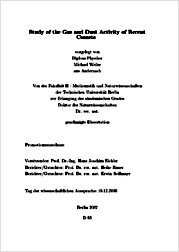| dc.contributor.author | Weiler, Michael | |
| dc.date.accessioned | 2010-10-12T18:25:24Z | |
| dc.date.available | 2010-10-12T18:25:24Z | |
| dc.date.issued | 2006 | |
| dc.identifier.uri | http://hdl.handle.net/11858/00-1735-0000-0001-30EB-5 | |
| dc.description.abstract | Comets belong to the most pristine objects in the Solar System. The study of comets therefore allows one to put constraints to the physical and chemical conditions in the pre-planetary disc. In this work, a one-dimensional simplified multi-fluid model for the analysis of the chemistry in cometary comae was constructed. This model was used for the study of the formation of the C3 and C2 radicals. For this purpose, radial profiles of the optical emissions of C3 and C2 in comets C/2001 Q4 NEAT, C/2002 T7 LINEAR, and 9P/Tempel 1 at heliocentric distances between 1.0 AU and 1.5 AU were analysed. These profiles were obtained by means of long-slit spectroscopy. A reaction network for the formation of C3 and C2 at larger heliocentric distances (Helbert 2002) was updated and extended. Molecules and radicals were identified for which photodissociation reaction rates have to be further constrained before the formation of C3 and C2 can be understood. As comets of special interest, the comets 67P/Churyumov-Gerasimenko and 9P/Tempel 1 were studied in more detail. Both comets are targets of space missions... | |
| dc.format.extent | 227 S. | |
| dc.format.mimetype | application/pdf | |
| dc.language.iso | eng | |
| dc.publisher | Univ. Berlin | |
| dc.rights.uri | http://e-docs.geo-leo.de/rights | |
| dc.subject.ddc | 523 | |
| dc.subject.gok | TGL 200 | |
| dc.title | Study of the gas and dust activity of recent comets | |
| dc.type | monograph | |
| dc.subject.gokverbal | Kometen {Astronomie} | |
| dc.identifier.doi | 10.23689/fidgeo-100 | |
| dc.identifier.ppn | 527664189 | |
| dc.type.version | publishedVersion | |
| dc.relation.collection | Astronomie, Astrophysik, Weltraumforschung | |
| dc.description.type | thesis | |


